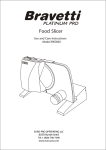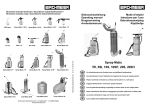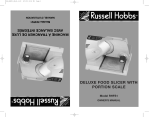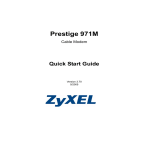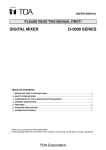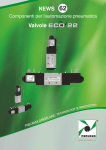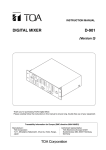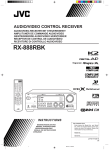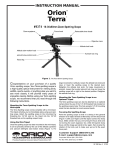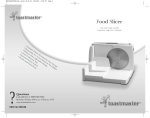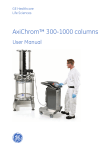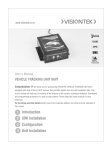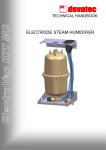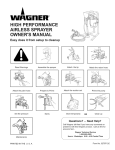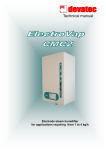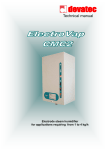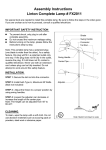Download Electronics Limited
Transcript
Electronics Limited Mega Electronics Limited., Mega House Grip Industrial Estate, Linton, Cambridge. ENGLAND. CB1 6NR Telephone: +44 01223 893900 Fax No: +44 01223 893894 email: megaelect.demon.co.uk. 1 1. CLEANER / CONDITIONER - ABC 188 ABC 188 Makeup 5 litres contains the following:a) 750 ml of concentrated 96% Sulphuric Acid, which gives a 15% concentration when mixed. b) 275 ml of ABC 188M c) 3975 ml of De-ionised Water. The function of the ABC 188 is to clean the surface of the copper and condition the holes to allow the palladium ions in the catalyst to be attracted to the surfaces of the drilled holes to give a very thin conductive layer to allow direct electroplating of copper down the holes. The Sulphuric acid cleans the copper surface of the board and etches very small amounts of the fibre glass from the hole. Because we recommend that the board surface is scrub cleaned with a Scotchbrite pad the Sulphuric acid concentration can drop as low as 10%. This means that unless a large throughput of boards is taking place, it is unlikely that analysis for Sulphuric acid will be required for people using system for small runs of boards. Also it is better to change the solution after one year or when it changes to olive green colour. The ABC 188M removes resin smears caused when the hole is drilled. These smears are a silica based product and will gradually cause the liquid to go from clear to green. When it turns olive green the bath needs to be renewed. The ABC 188M also causes an electric potential to be created in the holes and on the copper surface, which attracts the palladium particles (which are about 10 microns in size) to these surfaces to give a uniform conductive layer. The following important points must be observed . 1) The ABC 188 must be used between 60ºC – 70ºC. If temperature is below 60ºC some holes would start to be un-plated i.e. voids. If temperature is above 70ºC, it will cause the solution to breakdown and produce large jellylike particles which will stick to the board and in the holes, causing bad plating. If this has happened the solution should be replaced. 2) When the board has been removed from the ABC 188 and washed, it must then be put into the ABC 888 Catalyst tank immediately to prevent oxidisation of the copper surface. No ABC 188 solution must ever be allowed to get into the ABC 888 Catalyst tank.If it does, it would cause the Catalyst solution to drop out. 3) 2 2. CATALYST ABC 888 ABC 888 Makeup 5 Litres, contains the following:a) 4753 ml of ABC 888M (Part A) which contains approximately 15% Hydrochloric Acid. b) 265 ml of ABC 888R (Part B), which contains 65 grams of Stannous Chloride and 10 grams of Palladium Chloride. The function of the Catalyst is to coat the walls of the conditioned holes with a very thin uniform layer of Palladium to give a conductive path when the board is placed in the copper plating bath. During this process the copper surfaces also become coated with a layer of Palladium and tin and this has to be removed prior to electroplating copper in the ABC 580 Salt Remover Solution. The Catalyst solution is a colloid where the function of the tin chloride (Stannous Chloride) is to keep the Palladium particles suspended uniformly in the solution. Therefore to ensure the Catalyst functions properly and remains stable (This is the most expensive solution to replace) the following important points must be observed. 1) The ABC 888 must be used between 40ºC – 50ºC. The reason for this is that as the solution cools down to room temperature, the palladium particles stick to each other to form larger particles. In order to separate these particles the temperature of the solution must reach 40ºC. If this is not the case a non-uniform coverage of the hole walls could occur causing partly plated holes or voids. . If the temperature rises above 60ºC, this will cause the tin to oxidise out very quickly and the Palladium will then drop out of the solution, which will then go from dark brown / black to clear and cannot be regenerated except by adding 265 ml of ABC 888R (Part B). Cost approximately £100.00. 2) It is very important that no contaminating chemicals are introduced to the bath, especially from the ABC 188 Cleaner / Conditioner. If this happens the Palladium will again drop out, even if the tin content is correct and this time the solution will have to be completely replaced with a new Makeup (ABC 888M - Part A and ABC 888R - Part B). Cost approximately £200. This means that rinsing properly after the board comes out of the ABC 188 bath is most important 3 3) Owing to the high watts / sq. cm. of the heaters fitted to our tanks (approximately 10 watts / sq. cm), we have found that when the heater is on the tin will oxidise out at the rate of 16 grams for every 20 hours, the heater has been on. As the solution, when fresh contains 65 grams of tin and the level should not fall below half this, it is very important that the tin is replenished after every 20 hours of heating with: 15 grams of Tin (Stannous) Chloride Powder.* This should be stirred very well to mix all tin chloride into solution. * Available from us in 100 gram bottles. Part No: 500-153-2 @ £17.50 each 4) When the bath has not been used for a few days, it is recommended that after it has been heated up, it is stirred thoroughly using a clean plastic (PVC or polypropylene) rod or a strip of clean FR4 Fibreglass board with or without copper. 5) Other than replenishment with ABC 888T as described in (3), normal replenishment is made every 480 ampere hours, reading on the meter. This is done by adding 20 ml of each of the following: ABC 888M Replenisher ABC 888R Replenisher ABC 888RM Replenisher 6) For those who wish it is possible to analyse for tin levels using analysis instructions in our instruction manual. We also supply an analysis kit for this at a cost of approximately £80.00. (Part No: 500-174). 7) If you do not intend to use the solution for 2 months, it should be emptied into a clean plastic container (5 litres) or the original ABC 888M Part A container. and the top sealed 4 3. SALT REMOVER ABC 580 ABC 580 Makeup contains the following:- a) 275 ml of ABC 580M containing: 10% Potassium Carbonate, this reduces to less than 1% when made up. b) 4725 ml of Deionised water. The function of the Salt Remover is to remove Palladium and tin which has been attracted to the copper surfaces of the board without removing the Palladium from the holes. The following important points must be observed: 1) The ABC 580 should be used between 30ºC – 40ºC. If the temperature drops below 30ºC, this will mean that not all the Palladium and tin will be removed from the copper surfaces. This will cause poor plating and in some cases no plating in the holes. If the temperature rises above 40ºC, this could cause some Palladium to be removed from the holes and therefore partly plated holes or voids. 2) If the boards have brown areas or brown sludge in the holes, it could mean that the Salt Remover needs changing. It should also be changed when it has turned an olive green colour. 3) Replenishment should be carried out after 480 ampere hours on the meter by adding 15 ml of ABC 580M 5 4. COPPER PLATING SOLUTION ABC 9711 This solution is supplied ready to use in a 25 litre container. It contains: Copper sulphate 500 grams Sulphuric Acid 20% Chloride 40 – 50 parts per million The function of the copper plating solution, is to electrolytically plate copper on to the board surface and in the holes of the board which has gone through the three ABC treatment stages. This is done by having the solution in a plating tank which has two phosphorised plate anodes in anode bags along each side of the bath – a minimum distance of 100mm from the board surface, when it is placed in its holder in the centre of the tank. The tank is connected to a 50 amp / 3•5V D.C. ± 3% ripple power supply with the +VE side connected to the anode rails and the -VE side connected to the board holder rail. The recommended plating current is 3A / dm² per side with the board moving backwards and forwards across i.e. board 10cms x 10cms x would have the current set at: 3 x 10 x 10 x 2 = 6 amps 100 The maximum board size for our 25 litre tanks is 305mm x 255mm. PL903S The maximum board size for our 50 litre tanks is 305mm X 457mm PL904S Therefore if a board 305 x 255mm was used, the current would be: 30.5 x 25.5 x 3 x 2 = 48 amps 100 which is within the range of the power supply. 50 Amps PL903S 100 Amps PL904S When a line is first installed, the phosphorised anodes have to be oxidised. This is done by placing a board 30cm x 25cm in the tank and setting the current to 1 amp / dm² for 3 hours. i.e. 16 amps, or a board 30cm X 43 cm in the larger tank PL904S and plating for 4 hours at 28 Amps This is called electrolysing the solution and allows a dark brown / black oxide layer to be formed on the surfaces of the anodes which are in the liquid. 6 After this 125 ml of ABC 971M additive (Brightener) is added and plating at 1 amp / dm² is continued for 30 minutes. At all times when plating is taking place the oscillating frame motor should be switched on so that solution is pumped through the holes. Minimum stroke is about 3 cm and oscillating speed is 13 R.P.M. Also the air pump switch must always be on when current is passing to ensure vigorous agitation of the solution around the board, so that at 3A / dm² there is no burning to the surface of the board (i.e. blackening). Important points to observe. 1) If the solution has not been used for a few days, set the current and press ‘RUN’, then check the voltage. Normally it should not be more than 2 volts at 50 amps. If therefore voltage appears high, slide the anodes backwards and forwards on the anode rails and watch the voltage reduce. 2) If after plating for 10 – 20 minutes the voltage has risen considerably, and is still rising, this would mean that the anodes had become polarised i.e. lost their black oxide coating. Their colour would then be copper coloured or white to light grey. To correct this the anodes must be removed and scrub cleaned with a Scotchbrite pad, rinsed and then placed back inside the anode bags and returned to the plating tank. Add 2ml of 36% reagent or laboratory grade Hydrochloric Acid. Then electrolyse them again as explained in the last two paragraphs on page 5. 3) If the board looks matt or pink coloured after 10 minutes of plating or there is a build up of grainy copper at the bottom edges – add 25 – 50 ml of ABC 971M additive and continue plating. 4) If board is still dull or brown colour, it could be that the Salt Remover did not work properly. To check this – remove the board from the solution, rinse and scrub clean, then return to the plating bath and continue. 5) If the board is plating correctly and is shiny, but lots of particles are on the board surface making it feel rough, take another blank piece of board, scrub clean it then plate for 3 – 4 hours at 0•5 amps / dm². This will remove this particles normally caused when the solution has not been used for sometime or dirt or dust is getting into the solution. 7 6) If anodes have worn down, you could find voltage will increase as in (2), because there is not enough copper coming off the anodes to replace the copper being taken out of the solution. In the worst case, when the voltage reaches 3•5V, the power supply will go into limit condition and the set current will start to fall, causing the error light to come on. This light will also come on if you have poor contact. This is usually more noticeable if you are plating large boards and therefore taking high currents. 7. If for any reason the copper is not adhering properly i.e. tracks peel off after etching etc., this could mean the cleaner / conditioner has not cleaned the copper surface properly. If copper plating solution is not going to be used for 3 months or longer – it should be emptied into its original container. The anodes removed and washed in soapy water and scrubbed with Scotchbrite pad then dried. Also rinse out anode bags and allow to dry in air. Finally losses due to evaporation should be made up with deionised water in all tanks except the Catalyst which should be topped up with a 50% solution of Hydrochloric Acid, i.e. 1 part concentrated Hydrochloric Acid mixed with 1 part deionised water to give a 50% solution. When you are ready to start again, put anodes back in anode bags and hook back on anode rails. Add solution and re-electrolyse – See pages 6/7 in User Manual. file ref: E\mfg\ABC Chemicals.9749-3.pg 1-7.doc








